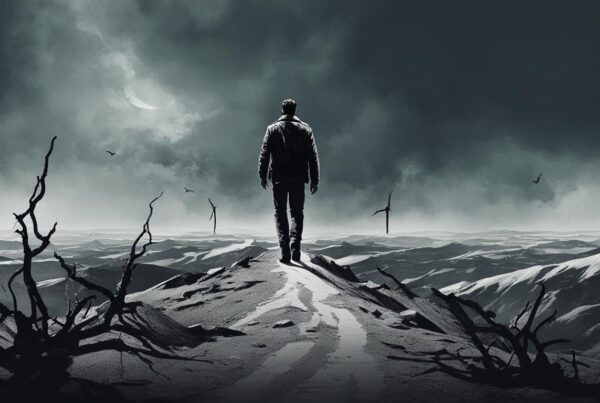Office dynamics have always been a rich vein for novelists to mine, and “Then We Came to the End” by Joshua Ferris is no exception. In this office life novel, readers are taken on a vivid journey through the hallways, cubicles, and conference rooms of a faltering advertising agency. Ferris, a masterful chronicler of the everyday, unpacks the rhythms and nuances of corporate existence with humor and pathos, earning a place for his work among the most poignant depictions of modern workplace culture.
This Then We Came to the End review aims to dissect the elements that make Ferris’s novel an accurate and enduring reflection of American office life. Shot through with the sharp dialogue and intricate social hierarchies that color our nine-to-five lives, the book offers a window into a world that is at once alien and intimately familiar. Whether in elevators, around water coolers, or behind glowing screens, “Then We Came to the End” holds a mirror up to the delicate ecosystem of office relationships and individual aspirations, making it a compelling read for anyone who has ever navigated the maze of corporate America.
Introducing “Then We Came to the End”
Joshua Ferris’s debut novel, “Then We Came to the End,” stands as an incisive portrayal of the complexities of office culture in literature. Diving into the heart of a tumultuous advertising agency, his narrative captures the essence of a workplace under the strains of economic adversity. It is in this ensemble cast and their intertwined narratives that the collective voice of employees comes to life, painting a portrait of the corporate world that is both poignant and critically incisive. As we peel back the layers of this contemporary classic, we find a narrative that has not only won accolades but also reshaped our perception of office life through its literary merits.
The premise of the novel
Set against the backdrop of the early 2000s dot-com bust, “Then We Came to the End” delves into the lives of characters facing the threat of layoffs and uncertainty at work. This setting serves as a compelling stage for exploring the human face behind the cubicles and computers, weaving a tale of survival, kinship, and the pursuit of purpose amidst the daily grind.
Award-winning narrative
The literary world took note of Ferris’s exceptional craft when his novel was honored with the prestigious PEN/Hemingway Award, solidifying its place in modern literary circles. The accolade is a testament to the book’s engrossing narrative and its unique ability to articulate the zeitgeist of a pivotal moment in office culture history.
Unique storytelling approach
What truly distinguishes “Then We Came to the End” is its innovative use of first-person plural narration—a device that merges individual and collective experiences into a singular, resonant chorus that echoes through the office corridors. This narrative style captures the essence of shared struggles and communal triumphs, setting it apart as a novel that speaks with, and for, its audience.
The Theme of Collective Consciousness in the Workplace
In “Then We Came to the End” by Joshua Ferris, the nuanced interplay of collective experiences forms the backbone of the novel, illustrating the profound impact of shared events on both corporate identity and workplace dynamics. Ferris adeptly captures the intricate ways in which individuals within a corporate environment are woven into a tapestry of collective consciousness, each employee an integral thread in the overall pattern of office life.
As the characters navigate their days, the seemingly mundane activities become charged with the energy of communal survival and shared destiny—a microcosm of human interaction amidst the trials of workaday existence.
The novel paints a vivid picture of how collective consciousness manifests in various facets of the workplace:
- Shared triumphs and tragedies that shape the emotional landscape of the office.
- Office rituals and inside jokes that foster a sense of belonging and comfort.
- Group responses to external pressures, like layoffs or shifts in management, which reveal the strength and fragility of the workplace community.
This shared consciousness does more than just define the social atmosphere; it becomes a defining element of the company’s identity and culture. It’s not just the policies or the products that make a corporate identity, but the living, breathing entity of its workforce experiencing each day as a unit.
Ferris masterfully explores how these collective experiences impact the individuals within them. Personal narratives intertwine with group dynamics, where each person’s sense of self is inevitably influenced by the actions and reactions of the collective. This delicate balance between individuality and group identity is a central theme in Ferris’s narrative, exploring how one influences and shapes the other.
The phenomenon of collective consciousness in the workplace does more than provide a backdrop for the novel’s action; it actively shapes the plot, driving relationships and events forward in meaningful and sometimes unexpected ways.
The exploration of this theme in “Then We Came to the End” ultimately delivers a richer understanding of the human condition within the modern corporate setting, delivering insights that resonate far beyond the page.
Characters That Resonate with the Corporate World
In “Then We Came to the End” by Joshua Ferris, readers find themselves immersed in the intricate web of workplace relationships that define the modern corporate space. Through skillful character analysis, Ferris lays bare the office stereotypes that we all recognize, creating characters who are not just figures on a page, but reflections of the people we encounter in our everyday professional lives.
Character development
The lifeblood of Ferris’s narrative lies in his characters, each meticulously crafted with an arc that mirrors the evolution one might experience in any given office environment. Ferris manages to encapsulate the challenges and growth that come with the territory of workplace hierarchy and politics. The characters exemplify workplace relationships in flux—ambitions clashing, alliances forming, and individual battles for recognition and stability within the larger group.
Relatable office dynamics
The realism in “Then We Came to the End” resonates particularly well through the relatable office dynamics Ferris portrays. In these characters, readers recognize the quintessential office stereotypes—the overachiever, the slacker, the boss everyone tiptoes around—and yet Ferris manages to turn these archetypes on their head, presenting them with a depth that invites empathy and understanding. By diving deep into the psyche of these individuals, Ferris reveals the complexities beneath the surface that often drive workplace relationships and interactions.

- The Gossip: Spreading rumors, yet often the first to know pivotal company news.
- The Workaholic: Constantly staying late, their dedication is both impressive and daunting.
- The Newbie: Eager to impress but prone to faux pas, they represent the continuous cycle of renewal within the workforce.
- The Mentor: Offering guidance and insight, they help navigate the corporate labyrinth.
The novel appeals to a broad audience as it encapsulates the everyday drama and routine of work life, capturing the humor, the pathos, and oddly enough, the beauty found within cubicle walls. Joshua Ferris’s portrayal of the corporate world in “Then We Came to the End” stands out for its acute character analysis and authentic depiction of office stereotypes, securing its place as a poignant narrative in modern American literature.
Crafting Humor in the Mundane: Ferris’s Writing Style
In the exploration of Joshua Ferris’s acclaimed work, “Then We Came to the End,” we uncover the masterful way in which humor is spun from the monotonous threads of office life. It’s this deft interplay between satire and reality that imbues the novel with a charm that captures the essence of workplace comedy. Through a closer look, we gain insights into how Ferris uses humor in literature to elevate the narrative beyond the confines of the cubicle.
Incorporation of Wit
The adroitness of Ferris’s prose lies in its ability to sprinkle mundane corporate discourse with an understated wit. His satirical writing intertwines with character dialogues and narrative arcs, gifting readers with periodic bursts of laughter amidst a realistic depiction of office banter. This humor acts as a social commentary, resonating with the everyday worker and providing that comedic relief so often found at watercoolers in bustling office landscapes.
The Role of Humor in Discussing Serious Themes
Humor is not merely an ornament in Ferris’s narrative arsenal; it serves a crucial role in unpacking and deconstructing the heavier themes that loom over the employees’ heads. Aspects such as existential dread, job insecurity, and the erosion of individuality under corporate policy are all addressed with a laugh, yet never undermined. This juxtaposition allows Ferris to use humor as a literary device to render vividly the dynamics of workplace comedy while engaging with thought-provoking topics that extend well beyond the office walls.
Exploring the Audiobook Review for “Then We Came to the End”
The transition of Joshua Ferris’s Then We Came to the End from text to audio opens up fresh avenues for literary enjoyment. An audiobook’s success depends heavily on the trio of audiobook performance, narration style, and the overall listening experience. These elements combined can either elevate the story to new heights or detract from the author’s original vision.
For listeners of Then We Came to the End, the audiobook performance is critical, particularly because the novel employs a unique collective voice that speaks to the shared experiences of office workers. The narrator’s ability to give life to this collective narration, while also distinguishing individual characters, is a testament to their skill and the depth of their understanding of the material.
Ferris’s book, known for its humor and poignancy, presents distinct challenges in the narration style. It requires a certain finesse to balance the comedic elements with the more serious undertones that traverse the story. A narrator’s interpretation can profoundly affect these tones, shifting how the humor lands and the impact of the narrative’s sadder moments. As such, the listening experience becomes a unique journey for each reader, colored by the narrator’s choices and delivery.
The listening experience of an audiobook can turn reading into a more immersive and accessible activity. For those who listen during their commutes or as they multitask, the voice acting quality and consistency in audio production are paramount for maintaining engagement. An excellent audiobook brings a novel’s environment to life, enhancing the listeners’ connection to the narrative without the need for visual cues.
In the case of Then We Came to the End, the element of performance is especially crucial. The audiobook must capture the zeitgeist of the corporate world with a keen sense of authenticity. Listeners expect a vivid portrayal that reflects the novel’s satirical edge and the all-too-familiar intricacies of office life. With this in mind, we dive into the nuances of the audiobook adaptation and weigh in on how it stands against the written word, focusing on its capacity to leave a lasting impression on its audience.
A Deep Dive into the Story’s Setting
Joshua Ferris’s “Then We Came to the End” paints a vivid picture of the modern office that serves not merely as a backdrop but as a pivotal force in driving the narrative. This section examines the intricate relationship between the setting and the storyline, highlighting Ferris’s use of descriptive storytelling to transform the conventional office into a complex, character-rich environment.

Importance of setting in the novel
The setting in Ferris’s work is far more than a physical space; it’s a tapestry woven with the threads of corporate culture, interpersonal dynamics, and the silent pressures of working life. An engaging setting analysis reveals that the office landscape is meticulously crafted to mirror the triumphs and tribulations of the characters, affirming its importance in the fabric of Ferris’s storytelling.
How the office environment shapes the story
Within the context of “office as a setting,” the physical geography of cubicles, conference rooms, and communal spaces emerges as a character in its own right, influencing the plot’s progression. Ferris’s keen observations dissect how the nuances of this environment—its sounds, its rhythms, and its very aura—affect the psyche and behavior of the cast. It’s in the casual dialogue by the watercooler and the silent judgments in the break room where the essence of the novel resonates.
The Impact of “Then We Came to the End” on Modern Literature
When Joshua Ferris penned “Then We Came to the End”, he tapped into the pulse of contemporary fiction with a candid depiction of the ebb and flow of office life. The literary influence of his collective voice narrative continues to reverberate through the corridors of modern literature. It’s not just the relatable content that makes this novel a jewel in the crown of modern classics; it’s also the innovative structure and keen social observations that have set a benchmark for authors exploring similar themes.
The response from the literary community was immediate, with critics praising Ferris’s agility in reflecting the nuances of corporate America. His sharp wit combined with a sweeping, empathetic understanding of his characters has enshrined this debut work as a significant point of reference in literary discussions. Here, we delve into specifics related to its grasp on readers and critics alike, affirming its modern classic status.
“Ferris has given us a novel that captures the zeitgeist of corporate office society, leaving an indelible mark on contemporary fiction.”
- Commentary on Office Culture: A mirror to the modern workforce, reflecting the existential dread of cubicles and the comradery borne out of shared 9-to-5 grievances.
- Stylistic Innovation: Employing a unique first-person plural narrative, it invites readers into the collective mindset of employees, highlighting the communal aspect of office dynamics.
- Critics’ Engagement: Garnering significant critical acclaim for its authentic portrayal and genuine literary merit.
- Influence on Future Narratives: For many a writer, the book serves as both inspiration and a challenge to convey the intricacies of everyday life.
“Then We Came to the End” has not merely catalogued the office experience but redefined the narrative possibilities for writers examining the seemingly mundane aspects of life. It stands as a touchstone for those aiming to capture raw human emotions behind the glossy veneer of corporate landscapes. This work’s ascendancy to the rank of modern classic is well-deserved, marking it as a title that transcends its era and continues to ignite conversations about office life in the literary world.
Comparing “Then We Came to the End” to Other Workplace Novels
The office novel genre is a trove of literary comparisons ripe for exploration. “Then We Came to the End” by Joshua Ferris stands as a unique model within this niche, offering a blend of humor, existential insight, and a candid peek behind the cubicle curtain. How does Ferris’s work stack up against other titans of the office novel pantheon? Let’s unravel the layers of similarity and tease out the strands of narrative innovation that make Ferris’s tale distinct.
Similarities with other office-related narratives
In many ways, “Then We Came to the End” shares common ground with classics such as “The Man in the Gray Flannel Suit” by Sloan Wilson or “Bartleby, the Scrivener” by Herman Melville. These narratives are steeped in the pressures and politics of workplace culture, reflecting the universal struggle between personal fulfillment and professional duty.
- Examination of corporate culture and its impact on the individual
- Themes of identity, purpose, and the search for meaning in the mundaneness of office life
- A cast of characters that represent various office stereotypes and roles
Differences and unique aspects of Ferris’s tale
While Ferris resonates with the familiar, he eschews the traditional by embracing a narrative innovation unheard of in the office novel genre. “Then We Came to the End” employs a collective first-person narrative, a daring move that melds individual stories into a communal voice, reflecting the inherently collaborative nature of office work. This narrative choice accentuates the shared experience of the layoffs and uncertainty faced by the characters, and sets Ferris apart in his literary technique.
- Use of a collective first-person narrative, challenging conventional storytelling modes
- Subtle interweaving of humor to dissect and soften the often harsh realities of office politics
- Insight into the dot-com era’s particular office dynamics, capturing a specific historical moment in corporate America
Conclusively, while drawing from a well-established genre, “Then We Came to the End” elevates itself through Ferris’s deft touch and originality, giving readers a refreshing perspective on the complexities of office life.
Conclusion
As we bring this exploration of Joshua Ferris’s “Then We Came to the End” to a close, it is evident that the novel’s intricate dissection of office life goes far beyond mere caricature or satire of the corporate world. Ferris’s adept storytelling captures the collective spirit and existential ennui so characteristic of modern American office culture, earning the narrative a place on the bookshelves of both literary aficionados and casual readers alike.
Final thoughts on Joshua Ferris’s novel
Diving deep into the complexities and humor of the everyday office experience, Ferris’s novel transcends the time of its setting, offering concluding thoughts that resonate with the universal truths about human relationships and personal aspiration set against the backdrop of the workplace. The concluding analysis of this novel underscores its power to speak to the human condition while being anchored in the specificity of office life’s ebb and flow.
The book’s relevance today
In considering the enduring relevance of “Then We Came to the End,” it is clear that the novel’s message continues to echo in today’s rapidly shifting work environments. Amidst technological advancements and cultural shifts, the fundamental human need for connection and understanding within the confines of our professional lives remains steadfast. Ferris’s acumen in portraying this, wrapped in a narrative that is as entertaining as it is enlightening, ensures that his debut continues to captivate and provoke thought with its timeless appeal.



